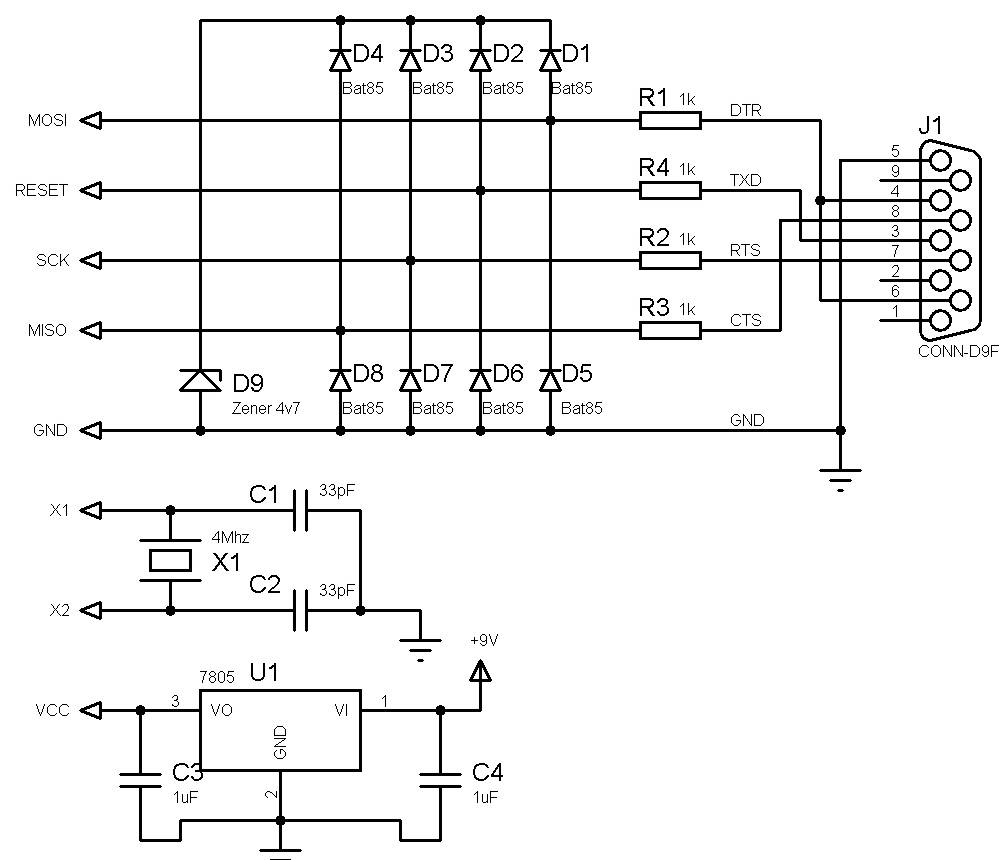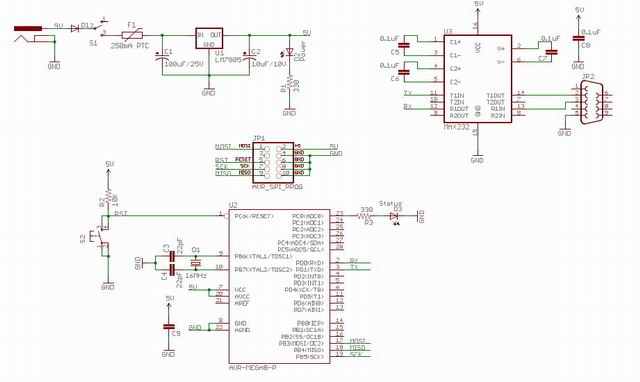sigmafullpac
Atmega8 Usb To Serial
Because the ATmega8 there is no facility for communication with the USB, then inevitably the data with the USB communication protocol must be made on the firmware itself. For a study guide the USB protocol can be seen in other parts of this website or click the link below to view it. In the firmware can be downloaded existing code to handle USB protocol, so that can be directly used, but if you want to add another facility, you can edit the firmware. The firmware provided is written in assembler language that can be done and compiled with AVR Studio 4.
In addition to code Assembl ernya also included his Hexa code compilation results of AVR Studio 4 which can be directly entered in his IC.Here is a circuit schematic drawing USB to Serial converter with ATmega8. USB data line of D + and D - connected to PB0 and PB1 in the ATmega8, this connection should not be changed because of these pins can be done with high-speed data transfer. For there was a connection and the opinion of a good signal between USB and devices, then ATmega8 be hired at Low Speed data rate that is the way her pull -up 1k5 Ohm resistor on the D- line data. For the other components are only used as a complement for the system to beropersai with good, for example Xtall used as a clock and used as a filter capacitor power supply.If at this circuit you want a USB to RS - 232 converter then you need to add the IC MAX 232 as Level converter from TTL to RS232 levels. If you only want to use to control the LED you can directly connect to the PIN I / O directly in series with a resistor before.For the implementation of the firmware as the USB receiver and coding of protocolnya, will receive all the packets of data from USB and then stored in an internal buffer.
Usb To Serial Belkin
Starting from the first revenues derived from external interrupt ( INT0 ) is the data to ' sync pattern ', during the admissions process only the last packet in the check the signal EOP ( End of Packet ). After the admissions process successfully, the next firmware will mong - coding a number of data packets it receives and then analyze it. Once again because of the USB protocol is very difficult you can read again the USB protocol on the following links. The process of receiving data on a USB in general can be seen in the following flowchart flow. Firmware is generally divided into several sections main blocks, namely:. Interrupt Routine. Decoding Routine ( Includes NRZI Encoding, BitStuffing Removal / Addition ).
USB Reception. USB Transmission. Requested Action Decoding.


Performing Custom Actions RequestedUsers can add the function of certain functions into the firmware, like the function to create a ' Customer - Specific ', function to ' Direct Pin Control ' and so forth.
Atmega8 Usb To Serial Adapter
Hi,I'm afraid that there is no solution.There is lot's of people reporting problems with W10 and Prolific devices (based on popular PL2303 adapter).Myself, I've the same problems with scrolling LED Badges, and USB to COM dongles. All this devices use a PL2303 to provide a connection to an USB port, but inside, they are RS232-like interface build (and appear as a COM port in your operating system). Whenyou plug the device into USB, it is well recognized by W10 and it try to load the Prolific driver.
After testing. FOUND THE SOLUTION!Indeed, when installing W10, the device driver for PL-2303 is the latest version. You can check it, using the configuration panel: watch the COM and LPT section, you should have the 'Prolific USB-to-Serial Comm (COM X)'. Click onproperties, and get the details:the version driver (ser2pl.sys or ser2pl64.sys) should be something like 3.6.78.350but this one doesn't work anymore with old PL-2303 hardware.Sometimes, installing the latest version of drivers solve the problem, but in this case, this is the opposite.The latest version doesn't work anymore with old hardware, and you need to downgrade the driver.If you have previously used the PL-2303 (with W7) and upgrade to W10, it's simple because the previous versions of the drivers are still on your computer. To downgrade, use the configuration panel, choose COM and LPT and right click: the first choice shouldbe 'update driver' (or something similar: sorry, but I've the French version, and hope my translation is understandable). On the next windows, choose the second option 'Look for a driver on my computer'.
Another windows appear, and select the bottom option:'choose from a list on my computer'. You should now have a list showing all versions of the driver available. By example:- Prolific USB-to-Serial Comm Port Version: 3.3.3.114- Prolific USB-to-Serial Comm Port Version: 3.4.48.272- Prolific USB-to-Serial Comm Port Version: 3.6.78.350You should select the old 3.3 (from 2009).Later version, like 3.4 or 3.6 report error code 10.I have tried with 3.3.2.102 and 3.3.3.114 and both works with old PL-2303 HXA/X hardware.If you don't have the old versions of drivers, you can tried to install them from the minidisc provided with your product. On mine, I have two programs (32 and 64 bits) called 'PL-2303 WIN7 Driver Installer.exe'.
Launch this program,it will install the driver. But, as soon as you plug the device on USB port, you W10 will revert to the latest version (3.6). If you watch the configuration panel, you will see the COM port coming OK, but then switch off because of error 10. It don't care,because the old version is now available in the list, and you can proceed as mentioned above.
Atmega8 Arduino

Once manually set, the device driver remain in the 3.3 release.Tested on W10 family and pro, 32/64 bits.The solution for old PL-2303 HXA/X: use a driver release older than 3.4.Edit: The procedure above works, but only temporary. Each time you turn your computer off, the latest driver is reloaded due to windows auto-update (or if you unplug and plug againthe device into USB port).To avoid that, a recent turnaround exist and has been published by Microsoft. It's a tool namedwushowhide.diagcab ('Show and Hide Update'). It allow to inhibit the auto-update for a particular program or driver (Prolific in our case).For more informations and where to download this tool, take a look at this article:I have tested it and it work fine. The only problem with it, is that, it reload the latest driver when you plug the device on a never used USB port.
So, if you change place of connection, you should manually set the driver to 3.3,but you have to do that only the first time you used this port. Next time, the driver remain to 3.3 and never upgrade to 3.6. Had the same troubles after WIN10 clean install. My device had chip version PL-2303XA/HXA which according Prolific is EOL and discontinued as of WIN8.Bought new device with PL-2303HXD chip, according Prolific supports WIN10 (32/64bit).Installed driver v3.6.81.357 09/04/15.